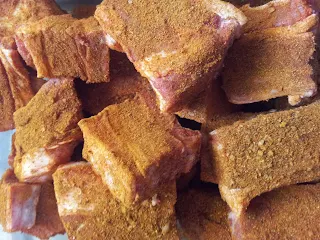Moroccan Beef Tagine
 |
| Moroccan Beef Tagine, with Sweet-and-Sour Couscous |
 |
| Beef short rib, or briske, as cut by the friendly butchers at Kloof Super-Spar |
The recipe itself has been already been adapted, in that traditional Moroccan tagines would usually employ either mutton (lamb) or chicken in their preparation, while this uses short ribs of beef, also known as brisket, and I in turn adapted a recipe from Williams Sonoma to beef up the vegetable components.
Since I was doubly fortunate, first in being given a beautiful, hand-decorated tagine from Morocco as a farewell present from the Women's Group:
Secondly, I was given a bottle of ras el hanout tagine spice from the Williams Sonoma store, courtesy of Cindi, scuba dive tour diva who lives in San Francisco. I therefore was obliged to make a tagine, and once embarked upon the process, found that all my doubts as to difficulty evaporated as quickly as the mist when the sun shines upon it.
 |
| Beautiful Morrocan and Arabian Objets d'Art |
Although your traditional tagine would probably be heavier on the meat, I added way more vegetables, based on the premiss that more in this regard is better than less (and you only need look at the new food pyramid for confirmation of the wisdom of that concept).
Secondly, I decided, in line with the original concept of a tagine, to braise the meat without searing it, since, after all, the original ceramic tagines, being pottery, do not allow for browning of the meat, and the finely ground spices are liable to be burnt while searing, which seems a waste of wonderfully, delicately fragrant spices, such as the ras el hanout (or "top of the shop") spice mixture I was fortunate enough to receive. For those who cannot access it, however, this Ras el Hanout Recipe will suffice (and I will be surely using this when I run out of mine).
The secrets to this particular stew are long, slow simmering (whether in a tagine on top of hot coals, in a lidded pot in the oven or even bubbling away on the stove); the concept of braising is that minimal water is used in a closed container with poor cuts of meat over a long period of time until the meat, literally falls off the bone and all the vegetables have turned into a thick, delicious gravy.
Moroccan Beef Tagine Recipe
Meat rub:
The bits of brisket should be at room temperature, and rubbed in a mixture of the following (which you will have pre-mixed before placing on the dry pieces of meat), at least one hour before starting the stew.
3 Tablespoons ras el hanout spice (if you have trouble finding it, try this: Ras el Hanout Recipe)
 |
| Brisket rubbed in the meat rub |
1 Tablespoon sweet paprika
1 teaspoon salt (preferably Maldon Smoked Sea Salt to go with the smokey flavours we are striving for, but really - any salt will do)
2.5 kgs of short beef ribs
1 large butternut
250 grams carrots (about 6 large carrots)
5 onions
12 cloves garlic (but then again, I like garlic)
½ cup wine
½ cup beef stock
olive oil
1 can tinned tomatoes, or 250ml pizza tomato paste - (1 cup)
Take out your largest pot, and place oil in the bottom. Chop the onions up small, and brown at high heat on the stove top (if it starts sticking too much, liberally shake red wine into the pot to deglaze).
 |
| Onions, carrots, butternut, sous-sous for the stew, sorry tagine |
 |
| Tagine, at the beginning of the stewing process |
 |
| The tagine is done |
This is best eaten with Sweet and Sour Couscous, which perfectly complements the sweet meat.



Looks yummy 👍🏻
ReplyDeleteThank you for sharing this wonderful blog with us. this is really helpful and informative.
ReplyDeleteMy pleasure!
Delete